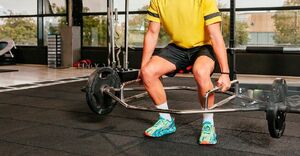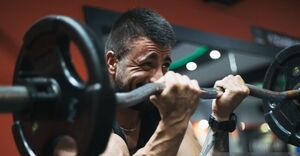
Perfecting the Barbell Row on a Smith Machine: Techniques and Tips
Looking to perfect your barbell row on a Smith machine?
This article covers everything you need to know, from the muscles worked to the correct form and common mistakes to avoid.
We provide step-by-step instructions on how to perform the exercise effectively and offer tips for improving your form.
We discuss variations of the barbell row on a Smith machine to help you switch up your workout routine.
Let’s dive in and master this essential exercise!
What is the Barbell Row on a Smith Machine?
The Barbell Row on a Smith Machine is a compound movement that targets various muscles in the back and arms, providing an effective workout for strength training enthusiasts.
By incorporating the use of a Smith Machine, this exercise offers a stable and controlled environment for performing rows, allowing individuals to focus on proper technique and form. Engaging muscles such as the lats, traps, and biceps, the Barbell Row on a Smith Machine promotes muscle development and strengthens the upper body.
By adjusting the weight load on the machine, users can gradually progress in strength training, making it suitable for both beginners and advanced lifters looking to enhance their fitness journey.
What Muscles Does the Barbell Row on a Smith Machine Work?
The Barbell Row on a Smith Machine primarily targets the back muscles, including the latissimus dorsi, rhomboids, and trapezius, while also engaging the biceps and forearms.
Engaging in this compound exercise not only helps in strengthening the upper back but also activates the posterior chain, a crucial muscle group for overall strength and stability. The latissimus dorsi, commonly known as the lats, plays a prominent role in shoulder extension and adduction, while the rhomboids and trapezius muscles aid in scapular retraction and shoulder stability. By performing the Barbell Row correctly with proper form, you not only enhance your back muscle development but also improve your grip strength and overall pulling power.
What is the Primary Muscle Worked?
The primary muscle worked during the Barbell Row on a Smith Machine is the latissimus dorsi, which is the largest muscle in the back responsible for shoulder extension and adduction.
When performing the Barbell Row on a Smith Machine, the latissimus dorsi plays a crucial role in pulling the weight towards the torso. This movement primarily targets the mid-back area, promoting strength and muscle development.
Activating the latissimus dorsi during this exercise helps improve posture and stability, which are essential for preventing injuries in daily activities. By focusing on proper technique, such as keeping the back straight and engaging the core, you can effectively engage and strengthen the latissimus dorsi for a well-rounded back workout.”
What are the Secondary Muscles Worked?
The secondary muscles worked during the Barbell Row on a Smith Machine include the rhomboids, trapezius, biceps, and forearms, which play supportive roles in stabilizing and assisting the primary muscle group.
Engaging these secondary muscles not only enhances the stability and overall control during the exercise but also contributes significantly to developing a strong and well-rounded back.
The rhomboids, situated between the spine and the shoulder blades, are crucial for scapular retraction, promoting proper posture and shoulder alignment.
The trapezius muscles, covering a large portion of the upper back and neck, aid in both shoulder and neck movements, reinforcing the upper back’s strength and stability.
The biceps and forearms come into play as synergists, assisting in the pulling motion and grip strength, thereby intensifying the workload on the back muscles for more effective muscle activation.
How to Perform the Barbell Row on a Smith Machine?
Perfecting the Barbell Row on a Smith Machine requires proper technique, a secure grip, and correct body alignment to ensure optimal muscle activation and prevent injury.
- Begin by standing in front of the barbell with your feet shoulder-width apart, ensuring a slight bend in the knees.
- Reach down to grasp the barbell with an overhand grip, hands slightly wider than shoulder-width apart.
- Keep your back straight and chest up as you lift the barbell off the rack or floor.
- Engage your core and pull the barbell up towards your lower chest, keeping your elbows close to your body.
- Lower the barbell back down in a controlled manner, feeling the contraction in your back muscles.
- Repeat for the desired number of reps, focusing on maintaining proper form throughout.
Step 1: Set Up the Smith Machine
- To begin the Barbell Row on a Smith Machine, set up the equipment at an appropriate height, ensuring the barbell is easily accessible and securely placed for the exercise.
- Next, adjust the height of the barbell on the Smith Machine to align with your mid-thigh level, allowing for a full range of motion during the exercise. Before starting, ensure that the safety clips are in place on both sides of the barbell to prevent any unwanted sliding or tipping.
- Take a moment to check your grip and stance, positioning your feet shoulder-width apart and maintaining a tight core for stability. By taking these steps to properly set up the equipment and prepare your body, you can optimize your form and maximize the effectiveness of the Barbell Row on the Smith Machine.
Step 2: Choose the Appropriate Weight
Selecting the appropriate weight for the Barbell Row on a Smith Machine is crucial to challenge your muscles effectively while maintaining proper form and technique throughout the exercise.
When determining the right weight for the Barbell Row, consider starting with a weight that allows you to perform 8-12 repetitions with proper form. It’s essential to choose a weight that provides enough resistance to stimulate muscle growth without compromising your technique. As you progress in your strength training journey, gradually increase the weight to continue challenging your muscles and promoting strength gains. By incorporating progressive overload and adjusting the intensity levels of your workouts, you can optimize your muscle growth and enhance your overall strength.
Step 3: Position Your Body
Properly positioning your body is essential for executing the Barbell Row on a Smith Machine correctly, ensuring that your back is flat, core is engaged, and shoulders are stabilized throughout the movement.
Maintaining proper body alignment during the exercise is crucial for maximizing results and preventing injury. Focus on engaging your core muscles to support your spine and maintain stability. Pay attention to your back posture to avoid strain and ensure efficient muscle engagement. Proper shoulder positioning is also key to prevent overloading the joints and maintain proper form. By emphasizing core stability, back posture, and shoulder health, you enhance the effectiveness of the exercise and promote overall body mechanics, ultimately ensuring a safe and productive workout.
Step 4: Execute the Movement
Executing the Barbell Row on a Smith Machine involves pulling the barbell towards your lower chest while maintaining a controlled movement, focusing on muscle contraction and full range of motion for optimal results.
- To further enhance the effectiveness of the Barbell Row, the fourth step involves smoothly lowering the barbell back down until your arms are fully extended, in a controlled manner.
- Maintaining a slight bend in your knees and a straight back throughout the movement is crucial for proper execution.
- Aim for a repetition range of 8-12 reps per set to target muscular endurance and strength development.
- By controlling the descent phase, you engage the muscles eccentrically, promoting greater muscle activation and growth.
- This controlled approach aids in building a strong posterior chain and improving overall back strength.
What are Common Mistakes to Avoid?
Perfecting the Barbell Row on a Smith Machine involves avoiding common mistakes such as arching your back, using momentum, and neglecting core engagement to prevent injuries and maximize muscle activation.
Maintaining a neutral spine position throughout the movement is crucial to protect your lower back. Engaging your core stabilizes your body and enhances the effectiveness of the exercise.
Remember to pull the bar towards your lower chest, keeping your elbows close to your body for optimal muscle engagement. Be mindful of the weight you are lifting; using too heavy a weight can compromise your form and lead to injury.
Prioritize quality over quantity to ensure steady progress towards your fitness goals.
Arching Your Back
One common mistake to avoid during the Barbell Row is arching your back, as this can lead to improper spinal alignment, reduced muscle engagement, and potential strain on the lower back.
To ensure a neutral spine and proper back alignment during this exercise, focus on maintaining a straight posture from your head to your tailbone. By keeping your back flat and core engaged, you can effectively target the muscles in your upper body while minimizing the risk of injury.
Arching the back not only lessens the effectiveness of the workout but also puts excessive stress on the lumbar region, leading to discomfort and potential long-term damage. Remember, quality form is key to maximizing the benefits of your back workout and preventing unwanted setbacks.
Using Momentum
Avoid using momentum while performing the Barbell Row on a Smith Machine to ensure that the muscles, rather than momentum, are responsible for lifting the weight, enhancing resistance levels and muscle activation.
This controlled technique not only targets specific muscle groups more effectively but also reduces the risk of injury by promoting proper form and muscle engagement throughout the exercise. By focusing on muscle contraction and maintaining steady movement, individuals can optimize their strength gains and overall performance. Maintaining a consistent pace and avoiding jerky movements allows for a smoother execution of the exercise, leading to improved muscle hypertrophy and strength development over time. Therefore, implementing these principles in resistance training can significantly impact one’s ability to achieve desired fitness goals.
Not Engaging the Core
Failing to engage your core during the Barbell Row can compromise stability, decrease the effectiveness of the exercise, and limit the benefits of core stability and overall muscle engagement.
When the core is not properly activated, the risk of injury increases as other muscles compensate for the lack of support from the core. This can lead to imbalances in muscle development and reduced overall strength.
By focusing on engaging the core throughout the movement, not only are you enhancing your stability, but you are also maximizing the targeted muscle activation, which translates to greater gains in strength and improved workout efficiency.
Consistent core engagement lays a solid foundation for a stronger, more balanced physique.
What are Tips for Improving Your Form?
Enhancing your form during the Barbell Row involves keeping your core tight, shoulders back and down, and focusing on the squeeze at the top of the movement to optimize muscle activation and maintain shoulder health.
To further refine your technique, experiment with different grip variations such as using an overhand grip or an underhand grip to target various muscles in your back. Maintaining a neutral spine throughout the movement is crucial for preventing any strain on your lower back.
Make sure to initiate the row by driving your elbows back and towards your hips, rather than just pulling with your arms. This ensures that you are fully engaging your lats and rhomboids for maximum muscle recruitment.
Implementing these tips will not only improve your form but also enhance the efficiency of your Barbell Row workout.
Keep Your Core Tight
Maintaining a tight core throughout the Barbell Row stabilizes your body, supports proper posture, and enhances resistance against the weight, utilizing core strength and improving muscle engagement.
This activation of the core not only helps in distributing the load evenly across your body but also ensures that your spine remains in a neutral position, reducing the risk of strain or injury.
When incorporating resistance bands into your workout routine, engaging the core becomes even more crucial as it adds an extra element of resistance that challenges your stability and strength.
By focusing on core stability, you can optimize your form, increase the effectiveness of the exercise, and target specific muscle groups more efficiently.
Experimenting with different exercise variations while keeping your core engaged allows for a well-rounded workout that targets various muscle groups and fosters overall strength and endurance.
Keep Your Shoulders Back and Down
Maintaining proper shoulder positioning by keeping them back and down during the Barbell Row enhances upper body strength, reduces strain on the shoulder joints, and aligns with fitness goals for muscle development.
This deliberate focus on shoulder placement is crucial in maintaining shoulder health and preventing common fitness challenges like shoulder impingement, where the tendons in the shoulder get compressed. By consciously engaging the shoulders in this exercise, individuals can avoid potential injuries and ensure that the targeted muscles are effectively activated.
Proper alignment also aids in maximizing the benefits of the workout, allowing for a more efficient transfer of power from the upper body muscles to the barbell, ultimately leading to improved strength gains over time.
Focus on the Squeeze
Emphasizing the squeeze at the top of the Barbell Row movement intensifies muscle activation, promotes strength building, and ensures full contraction of the targeted muscle groups for optimal results.
When you focus on the squeeze during the Barbell Row, you are essentially engaging the targeted muscles even more efficiently. The squeeze not only enhances muscle activation but also plays a crucial role in achieving peak contraction, which is vital for muscle growth and strength development.
By mastering the muscle activation techniques, such as initiating the movement from a stabilized core and maintaining proper form throughout, you are not only maximizing the effectiveness of the exercise but also minimizing the risk of injury.
This heightened muscle engagement leads to increased strength gains, as the muscles are forced to work harder and adapt to the demands placed upon them.
What Are Some Variations of the Barbell Row on a Smith Machine?
Exploring different variations of the Barbell Row on a Smith Machine, such as underhand grip, wide grip, and single-arm row, can add diversity to your workout routine, target specific muscle groups, and enhance overall fitness progress.
These variations not only offer a challenging twist to your regular routine but also allow you to focus on engaging different muscle groups more effectively. The underhand grip variant, for instance, places more emphasis on the biceps and upper back, while the wide grip version targets the lats and rear delts. Incorporating single-arm rows can help improve symmetry and unilateral strength, enhancing overall muscle development. By including these different Barbell Row variations, you can overcome plateaus, prevent muscle imbalances, and keep your workouts fresh and exciting.
Underhand Grip
Utilizing an underhand grip during the Barbell Row on a Smith Machine shifts the emphasis to the biceps and forearms, promoting muscle development in these areas while enhancing grip strength and exercise efficiency.
This grip variation also engages the brachialis and brachioradialis muscles, contributing to a more comprehensive arm workout. By incorporating underhand grip movements into your routine, you not only target different muscle groups but also challenge your grip strength in a unique way. This increased focus on grip strength can lead to improvements in other weightlifting exercises, as a stronger grip translates to better stability and control when handling heavier weights during various lifts.
Wide Grip
Employing a wide grip during the Barbell Row on a Smith Machine increases the range of motion, engages the back muscles more effectively, and stimulates muscle growth, facilitating fitness progress and workout efficiency.
This wider grip not only targets the muscles in the back but also places increased emphasis on the biceps and forearms, leading to a more balanced development throughout the upper body. By extending the arms further apart, the chest muscles are also engaged to a greater extent, providing a full upper body workout. Utilizing a wide grip not only challenges the muscles in new ways but also enhances overall strength and endurance, pushing individuals closer towards their fitness goals.
Single Arm Row
Incorporating the single-arm row variation into your routine on a Smith Machine enhances unilateral strength, improves muscle balance, and utilizes the pulley system for resistance training, fostering well-rounded fitness development.
This exercise is particularly beneficial for targeting each side of your body separately, ensuring that any strength imbalances between your dominant and non-dominant sides are addressed.
By engaging in unilateral movements like the single-arm row, you not only strengthen individual muscles but also improve coordination and stability.
The pulley system on the Smith Machine provides adjustable resistance levels, allowing you to customize the intensity of your workout and effectively target specific muscle groups for optimal activation and growth.




No Comments